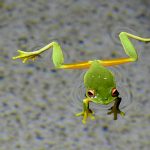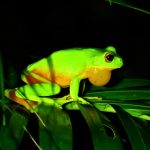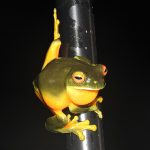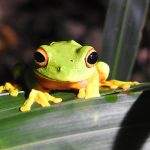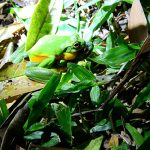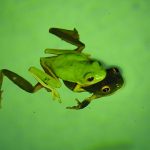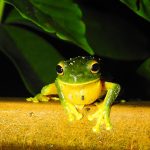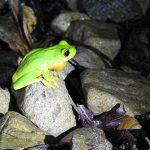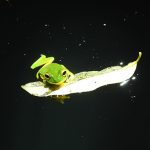ORANGE-THIGHED FROG
The Orange-thighed Frog is a fascinating amphibian native to Australia, specifically found in the lush rainforests of north-eastern Queensland. The species was only formally described in 1966, highlighting the rich biodiversity of Australia’s rainforests that continues to be studied and understood.
It is a small to medium-sized frog, typically measuring around 4 to 5 centimetres in length. Its most striking feature is the vibrant orange colouration on the underside of its thighs, which contrasts beautifully with its predominantly green body. The back is usually a bright, leafy green, sometimes speckled with brown or gold, providing excellent camouflage among the foliage. Its skin is smooth and moist, typical of many frog species.
This frog makes its home in the tropical rainforests of north-eastern Queensland, particularly from the Paluma Range to the Big Tableland near Cooktown. It thrives in wet environments, often found near streams, creeks, and other water bodies within the rainforest.
The Orange-thighed Frog is an insectivore, feasting on a diet of various insects and other small invertebrates. It uses its sticky tongue to catch prey, which includes beetles, moths, and spiders, contributing to its role in controlling insect populations.
Breeding occurs during the wet season, from November to March, when the rainforests are lush and teeming with life. Males call to attract females, producing a soft, repetitive “wark-wark-wark” sound that resonates through the forest. Females lay their eggs in water, where they hatch into tadpoles. These tadpoles undergo metamorphosis, eventually transforming into adult frogs.
While precise data on their lifespan in the wild is limited, frogs in similar environments generally live for several years. Factors such as predation and environmental conditions can influence their longevity.
The Orange-thighed Frog is currently classified as “Least Concern” by the International Union for Conservation of Nature (IUCN). However, like many rainforest inhabitants, it faces threats from habitat destruction, climate change, and pollution. Conservation efforts focus on preserving their natural habitats and ensuring the health of the rainforest ecosystems.
The call of the Orange-thighed Frog is a key part of its breeding ritual. The males’ calls are not only crucial for attracting mates but also establish territories among competing males. The sound is a soft, rhythmic “wark-wark-wark,” which can be heard echoing through the forest during the breeding season.
By understanding and appreciating the Orange-thighed Frog, we gain insight into the delicate balance of rainforest ecosystems and the importance of conserving these unique habitats for future generations.

